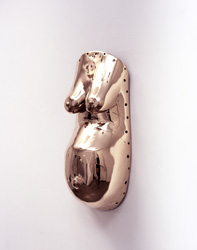Sherrie Levine, Body Mask, 2007.
Born 1947 in Hazleton, Pennsylvania; lives in Santa Fe, New Mexico, and New York, New York
Deploying a wide range of media including photography, painting, and bronze, Sherrie Levine’s work raises questions about art’s relationship to originality, authorship, and authenticity. Since the late 1970s, much of her practice has been posited as an explicit, secondary return to prior works by mostly male modern masters, notably in her early photographs including After Walker Evans (1981), for example, created by rephotographing a familiar picture by Walker Evans reproduced in an exhibition catalogue.
Levine’s After Stieglitz (2007) consists of eighteen digitized and pixilated photographic prints after American photographer Alfred Stieglitz’s Equivalents series from the 1920s and 1930s; his analogue images of clouds were said to be abstract correlatives of the photographer’s own experiences and feelings. In Levine’s recent return, however, the artist transmogrifies Stieglitz’s otherwise straight images, abstracting and digitizing them further—depersonalizing or repersonalizing them, depending on the viewer’s perspective. Like most of her work, After Stieglitz can be understood as a hall of mirrors—a series of pictures within pictures.
A related series, After Cézanne (2007), is a suite of eighteen pixilated photographic prints that transforms Paul Cézanne’s painted and fractured nineteenth-century vision of the natural world including trees and rocks into a colorful, digitized matrix abstraction peculiar to our own twenty-first-century way of seeing. In both series, Levine reproblematizes the terms of nature and culture, original and copy, leaving behind abstract ghosts of earlier pictures. “I want to put a picture on top of a picture,” Levine says. “This makes for times when both disappear and other times when they’re both visible. That vibration is basically what the work’s about for me—that space in the middle where there’s no picture, but emptiness.”
Levine’s Makonde Body Masks (2007) is a set of polished bronze works cast after ritualistic masks belonging to the Makonde from southeastern Tanzania, and hung as a horizontal series of repeating forms. In their original cultural context, the female body masks were intended to represent a young pregnant woman and were worn by male masqueraders together with matching female face masks during initiation rites (the latter included songs and dance instructing youths in roles of gender and sexuality). Recast by Levine in bronze and presented as presumably expensive luxury art objects, the artist raises questions about the relationship between the ritual and exhibition functions of masks and the different roles and cultural significance that replication plays within each. TODD ALDEN
Sherrie Levine, Body Mask, 2007. Cast bronze, 22 1/2 x 9 1/2 x 5 3/4 in. (57.2 x 24.1 x 14.6 cm). Collection of the artist; courtesy of the Paula Cooper Gallery, New York
























